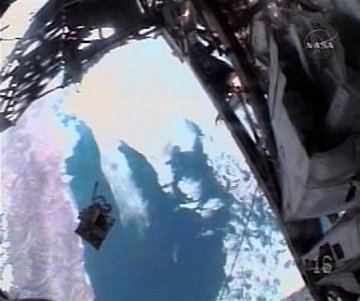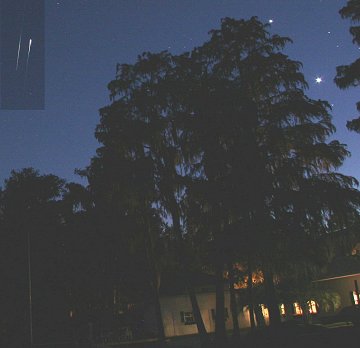| THANKSGIVING SKIES: Thanksgiving is the biggest travel holiday of the year in the United States. Millions of people board airplanes and fly long hours to visit friends and family. Dreading the trip? Think of it as a sky watching opportunity. There are some things you can see only through the window of an airplane: full story. ISS TOOLBAG: When Endeavour astronaut Heidemarie Stefanyshyn-Piper dropped her toolbag during a spacewalk on Nov. 18th and it floated away, mission controllers probably thought they'd seen the last of it. Think again. Amateur astronomers have been monitoring the backpack-sized toolbag as it circles Earth not very far from the International Space Station. (continued below) 
Above: NASA TV footage of the runaway toolbag.
After sunset on Nov. 22nd, Edward Light saw the bag using 10x50 binoculars as it sailed over his backyard in Lakewood, New Jersey. "It was quite a favorable 70-deg pass in clear skies," he says. "The visual magnitude of the bag was about +6.4 plus or minus half a magnitude." On the same night, Keven Fetter of Brockville, Ontario, video-recorded the bag zipping past the 4th-magnitude star eta Pisces: 900 kB movie. "It was easily 8th magnitude or brighter," says Fetter. This week the toolbag is making a series of passes over Europe; late next week it will return to the evening skies of North America. Using binoculars, look for it flying a few minutes ahead of the ISS. Spaceweather's satellite tracker is monitoring both the space station and the tool bag; click here for predictions. SUNSET SKY SHOW: On one side of the sky, two bright planets converge. On the other side, two bright satellites meet and flare. On the ground, a photographer presses the button on his camera (a Canon 30D). Perfect timing: 
Click to view the full-sized image
"Venus and Jupiter were shining threough a gap in the clouds last night when a pair of Iridium satellites passed overhead," says Mark Staples of Waldo, Florida. Sunlight glinted off the satellites' flat antennas, producing two supernova-like flares "within 20seconds and 1o of each other. The brighter flare was already half-finished when I started the exposure." Double Iridium flares are uncommon. There are 66 active Iridium satellites orbiting Earth, but they don't often cross paths at the exact moment of a flare. In this case, an on-orbit spare in a lower orbit lapped a higher, primary Iridium satellite; they met in sunlight and oh-so-briefly stole the show from Venus and Jupiter. Readers, keep an eye on the sunset sky tonight. Venus and Jupiter are still there, rapidly converging for a spectacular conjunction with the Moon at the end of the month. It's a lovely show--no Iridium required. Sky maps: Nov. 26, 27, 28, 29, 30, Dec 1. more images: from Gary A. Becker of Coopersburg, Pennsylvania; from Jorge Solano of Guatemala City, Guatemala; from Mahdi Zamani of Tehran, Iran; from Alex Roca of Hortoneda, Lleida. Spain; from Doug Zubenel of De Soto, Kansas; from Gordon Garcia of Bartlett, Illinois; from Sabahattin Bilsel of Gokcebel, Bodrum, Turkey
Nov. 2008 Aurora Gallery
[Previous Novembers: 2007, 2006, 2004, 2003, 2001, 2000] | 
